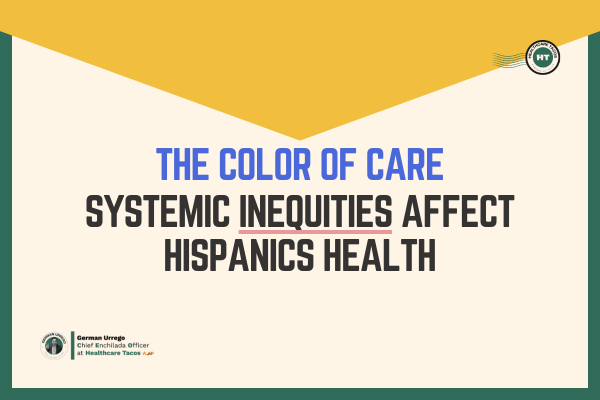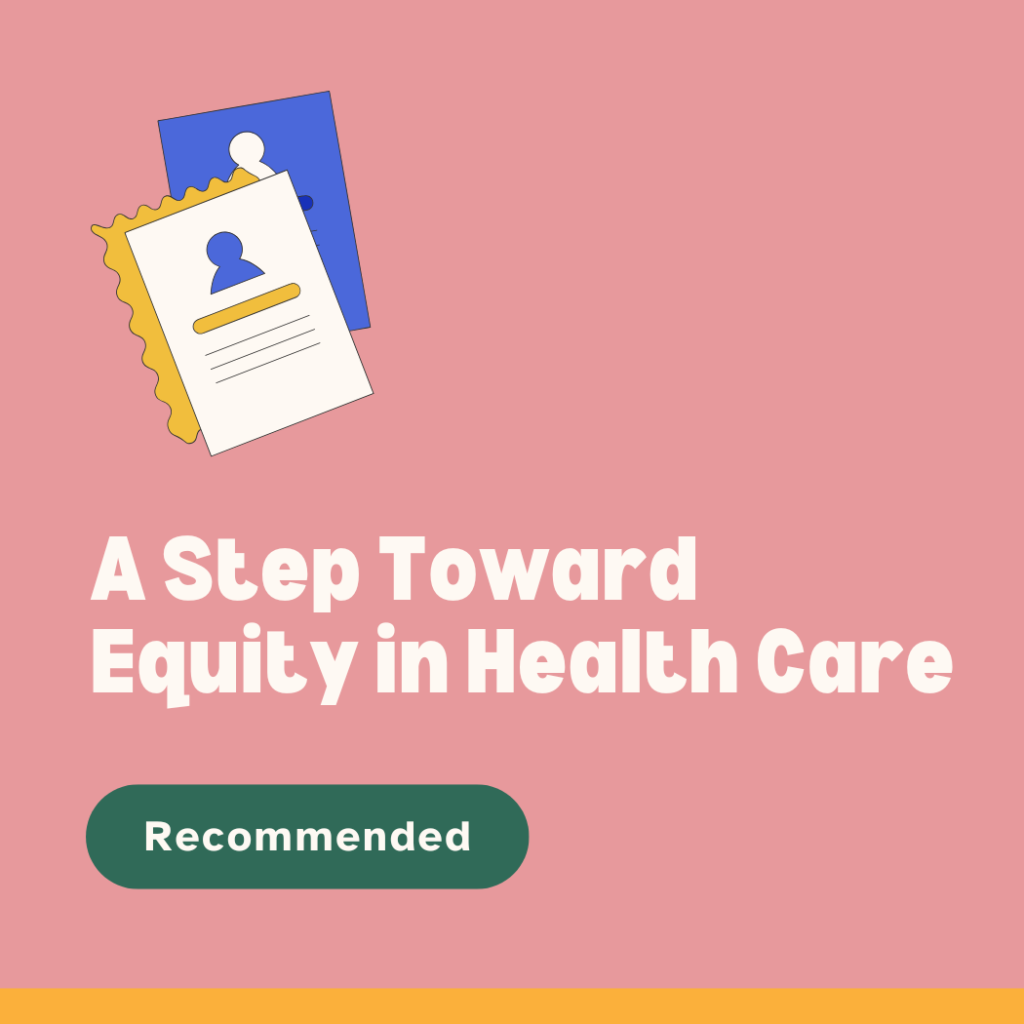

Amig@s – let’s talk about the color of care.
Have you ever been discriminated against? I have.
I’ve been kicked out of a clinic and denied health services because the lyrics of my documents didn’t rhyme right.
If this sounds like a song, it is, though I’ve changed it up a bit.
These are the lyrics from one of my favorite tracks, “Cleaning Out My Closet,” from The Eminem Show.
But here’s the hard truth.
Those words echo not just in Eminem’s song but in the lived experiences of countless Hispanics.
Whether intentional or not, bias runs deep through many healthcare organizations.
And guess what?
For millions of Hispanics, this bias is NOT just a fleeting feeling. It’s a reality that impacts their well-being, dignity, and trust in the system.
So, let’s taco ‘bout this enchilada.
Amig@s – let’s talk about the color of care.
Have you ever been discriminated against? I have.
I’ve been kicked out of a clinic and denied health services because the lyrics of my documents didn’t rhyme right.
If this sounds like a song, it is, though I’ve changed it up a bit.
These are the lyrics from one of my favorite tracks, “Cleaning Out My Closet,” from The Eminem Show.
But here’s the hard truth.
Those words echo not just in Eminem’s song but in the lived experiences of countless Hispanics.
Whether intentional or not, bias runs deep through many healthcare organizations.
And guess what?
For millions of Hispanics, this bias is NOT just a fleeting feeling.
It’s a reality that impacts their well-being, dignity, and trust in the system.
So, let’s taco ‘bout this enchilada.
![]()
Three Insights 🌶️
I. The Hidden Cost of Implicit Bias
Bias in healthcare is NOT always obvious, but it has serious consequences.
For Hispanic patients.
This can look like doctors underestimating their pain or assuming they won’t follow treatment plans.
These judgments might seem small at the moment, but they add up to major problems.
When we, as patients, are NOT heard or understood.
Guess what happens?
Our conditions can worsen, and critical signs might be missed.
This is NOT just unfair.
It actually leads to lower quality care and, in some cases, dangerous delays in treatment.
Over time.
These experiences break down trust between patients and providers.
And, as you and I know, when trust is gone. Hispanic patients might avoid seeking care altogether, even when they need it.
Creating a cycle where health outcomes worsen and disparities grow even deeper.
But this point is NOT just about individual interactions.
This bias also operates at the macro level, from frontline care up to the executive C-suite.
II. Health Inequity is Not Just a Gap, It’s a Canyon
Health disparities go far beyond occasional mistreatment or poor service.
If you ask me today, I’d say they are built into the system 100%.
For Hispanics, there are deep-rooted issues like.
- Lack of specialists
- Underfunded clinics
- Gaps in insurance coverage
These challenges are NOT just inconveniences. They create a wide canyon that separates many from the care they need.
Take this for instance:
- When clinics lack funding, they struggle to provide essential services, let alone specialized care.
- When insurance options are limited, essential treatments become unaffordable.
- When there are NOT enough bilingual or culturally competent specialists, communication breaks down. This leads to missed diagnoses or ineffective treatments.
The result of the three points above?
A massive divide that can mean the difference between life and death for millions of Hispanics.
Do not believe me; take a look yourself.
Of course, preventing them from getting the care they need.
Now, closing this canyon requires systemic changes at every level of healthcare.
But let’s be clear.
Health equity is NOT just about adding more services to your business lines.
It’s about ensuring every single patient.
Regardless of location or language, they can access the care they need without barriers.
III. Lack of Representation=Lack of Advocacy
Amig@s, pay attention; this is crucial.
When leadership lacks representation from Hispanics, critical issues often go unaddressed.
This is NOT just about having someone who looks like you at the table.
It’s about having leaders who truly understand and advocate for your (my, our) needs.
Without these voices.
Policies and decisions are made without considering the unique challenges faced by Hispanics.
For example, key issues like:
- Language accessibility
- Culturally appropriate care
- Fair resource distribution
They can be easily overlooked if there’s no one advocating for them (us, me).
Think about it this way.
Why do many medications and treatments fail to work as effectively for Hispanics?
It’s simple. The vast majority of clinical trials do NOT include enough Hispanics.
Instead.
The standard population is used as the norm. Unfortunately, this leads to treatments NOT tailored to everyone.
So, let’s finish with this.
Remember, true representation goes beyond just filling a seat.
It’s about ensuring real-life needs are considered at every level of decision making.
Insights
I. The Hidden Cost of Implicit Bias
Bias in healthcare is NOT always obvious, but it has serious consequences.
For Hispanic patients.
This can look like doctors underestimating their pain or assuming they won’t follow treatment plans.
These judgments might seem small at the moment, but they add up to major problems.
When we, as patients, are NOT heard or understood.
Guess what happens?
Our conditions can worsen, and critical signs might be missed.
This is NOT just unfair.
It actually leads to lower quality care and, in some cases, dangerous delays in treatment.
Over time.
These experiences break down trust between patients and providers.
And, as you and I know, when trust is gone.
Hispanic patients might avoid seeking care altogether, even when they need it.
Creating a cycle where health outcomes worsen and disparities grow even deeper.
But this point is NOT just about individual interactions.
This bias also operates at the macro level, from frontline care up to the executive C-suite.
II. Health Inequity is Not Just a Gap, It’s a Canyon
Health disparities go far beyond occasional mistreatment or poor service.
If you ask me today, I’d say they are built into the system 100%.
For Hispanics, there are deep-rooted issues like.
- Lack of specialists
- Underfunded clinics
- Gaps in insurance coverage
These challenges are NOT just inconveniences. They create a wide canyon that separates many from the care they need.
Take this for instance:
- When clinics lack funding, they struggle to provide essential services, let alone specialized care.
- When insurance options are limited, essential treatments become unaffordable.
- When there are NOT enough bilingual or culturally competent specialists, communication breaks down. This leads to missed diagnoses or ineffective treatments.
The result of the three points above?
A massive divide that can mean the difference between life and death for millions of Hispanics.
Do not believe me; take a look yourself.
Of course, preventing them from getting the care they need.
Now, closing this canyon requires systemic changes at every level of healthcare.
But let’s be clear.
Health equity is NOT just about adding more services to your business lines.
It’s about ensuring every single patient.
Regardless of location or language, they can access the care they need without barriers.
III. Lack of Representation=Lack of Advocacy
Amig@s, pay attention; this is crucial.
When leadership lacks representation from Hispanics, critical issues often go unaddressed.
This is NOT just about having someone who looks like you at the table.
It’s about having leaders who truly understand and advocate for your (my, our) needs.
Without these voices.
Policies and decisions are made without considering the unique challenges faced by Hispanics.
For example, key issues like:
- Language accessibility
- Culturally appropriate care
- Fair resource distribution
They can be easily overlooked if there’s no one advocating for them (us, me).
Think about it this way.
Why do many medications and treatments fail to work as effectively for Hispanics?
It’s simple.
The vast majority of clinical trials do NOT include enough Hispanics.
Instead.
The standard population is used as the norm. Unfortunately, this leads to treatments NOT tailored to everyone.
So, let’s finish with this.
Remember, true representation goes beyond just filling a seat.
It’s about ensuring real-life needs are considered at every level of decision making.
![]()
Two Actionable Steps 🌮
I. Mandate Bias Training Focused on Accountability
Here’s the key point.
Raising awareness of biases is only the beginning.
Any training program needs to go beyond that and focus on genuine accountability.
Here is a great article on training healthcare professionals.
This means implementing training that not only helps staff recognize and address their own biases.
But also outlines the consequences of discriminatory behavior.
This is NOT just about acknowledging bias.
It’s about challenging it and creating an environment where fairness is the standard.
Effective training programs should include two key elements:
- Real-world scenarios
- Interactive components
These elements help staff understand the real impact of their actions on patient care.
But knowledge alone is NOT enough.
To drive real change.
There needs to be a clear expectation that employees will put what they’ve learned into practice.
Though this might sound challenging, it’s not.
You can set up systems to collect feedback and review it regularly to identify problem areas.
This ongoing feedback loop helps hold staff accountable and allows for corrective action.
In essence.
Bias training should aim to create a culture where accountability and fairness are non negotiable.
This is how real change begins.
II. Collaborate with Community Health Leaders
Building genuine connections with Hispanics requires more than internal efforts.
It demands active partnerships with trusted community health leaders and organizations.
Believe it or not.
These local advocates have deep insights into the needs and challenges of Hispanics.
Making them essential allies in improving healthcare outreach and services.
By following this path. You can co create initiatives that are relevant, accessible, and sustainable.
Closing the trust gap between organizations and Hispanic patients.
Here’s why.
When community leaders are involved, patients are more likely to feel heard, respected, and valued.
This fosters stronger relationships and better health outcomes.
But remember, this is NOT just about involving community leaders in outreach.
It’s, in fact.
About giving them a real seat at the table in all decision-making processes, such as:
- Developing health programs
- Designing communication strategies
- Creating services that reflect the realities of Hispanics
Another great reason for engaging in this way is that these collaborations can help identify and address critical gaps in care, such as:
- Health literacy
- Language barriers
- Accessibility issues
Ultimately working together in this way.
Ensures initiatives are not only designed with cultural competency but practical and impactful.
Creating an effective team.
To approach and lower social determinants of health (SDOH) barriers for Hispanic communities.
Actionable Steps
I. Mandate Bias Training Focused on Accountability
Here’s the key point.
Raising awareness of biases is only the beginning.
Any training program needs to go beyond that and focus on genuine accountability.
Here is a great article on training healthcare professionals.
This means implementing training that not only helps staff recognize and address their own biases.
But also outlines the consequences of discriminatory behavior.
This is NOT just about acknowledging bias.
It’s about challenging it and creating an environment where fairness is the standard.
Effective training programs should include two key elements:
- Real-world scenarios
- Interactive components
These elements help staff understand the real impact of their actions on patient care.
But knowledge alone is NOT enough.
To drive real change.
There needs to be a clear expectation that employees will put what they’ve learned into practice.
Though this might sound challenging, it’s not.
You can set up systems to collect feedback and review it regularly to identify problem areas.
This ongoing feedback loop helps hold staff accountable and allows for corrective action.
In essence.
Bias training should aim to create a culture where accountability and fairness are non negotiable.
This is how real change begins.
II. Collaborate with Community Health Leaders
Building genuine connections with Hispanics requires more than internal efforts.
It demands active partnerships with trusted community health leaders and organizations.
Believe it or not.
These local advocates have deep insights into the needs and challenges of Hispanics.
Making them essential allies in improving healthcare outreach and services.
By following this path.
You can co create initiatives that are relevant, accessible, and sustainable.
Closing the trust gap between organizations and Hispanic patients.
Here’s why.
When community leaders are involved, patients are more likely to feel heard, respected, and valued.
This fosters stronger relationships and better health outcomes.
But remember.
This is NOT just about involving community leaders in outreach.
It’s, in fact.
About giving them a real seat at the table in all decision-making processes, such as:
- Developing health programs
- Designing communication strategies
- Creating services that reflect the realities of Hispanics
Another great reason for engaging in this way is that these collaborations can help identify and address critical gaps in care, such as:
- Health literacy
- Language barriers
- Accessibility issues
Ultimately working together in this way.
Ensures initiatives are not only designed with cultural competency but practical and impactful.
Creating an effective team.
To approach and lower social determinants of health (SDOH) barriers for Hispanic communities.
![]()
One Piece of Advice 💃
I. Embed Equity into Your DNA
By now, you know where I stand.
Equity is NOT just a box to check or a one-time initiative. And it’s definitely not just a month of celebration.
It needs to be woven into the fabric of your organization.
Think of equity as nurturing a plant.
You can NOT just water it once and expect it to thrive; it requires constant attention, care, and intention.
To truly embed equity into your organization’s DNA.
You’ve got to start by looking at your core values and how they manifest in your actions.
Here are some questions to consider:
- Are your policies inclusive?
- Do your initiatives actively address disparities in care?
- Does your staff reflect the diversity of your community?
- Is your leadership representative of the community you serve?
Now, remember this.
These are NOT questions to ask just once. You have to revisit them regularly as your organization evolves.
Why?
Because integrating equity means holding everyone accountable, and that requires consistent follow-ups.
So don’t forget to:
- Set clear goals
- Check progress
- Ensure everyone understands their role
Piece of Advice
I. Embed Equity into Your DNA
By now, you know where I stand.
Equity is NOT just a box to check or a one-time initiative. And it’s definitely not just a month of celebration.
It needs to be woven into the fabric of your organization.
Think of equity as nurturing a plant.
You can NOT just water it once and expect it to thrive; it requires constant attention, care, and intention.
To truly embed equity into your organization’s DNA.
You’ve got to start by looking at your core values and how they manifest in your actions.
Here are some questions to consider:
- Are your policies inclusive?
- Do your initiatives actively address disparities in care?
- Does your staff reflect the diversity of your community?
- Is your leadership representative of the community you serve?
Now, remember this.
These are NOT questions to ask just once. You have to revisit them regularly as your organization evolves.
Why?
Because integrating equity means holding everyone accountable, and that requires consistent follow-ups.
So don’t forget to:
- Set clear goals
- Check progress
- Ensure everyone understands their role
![]()





